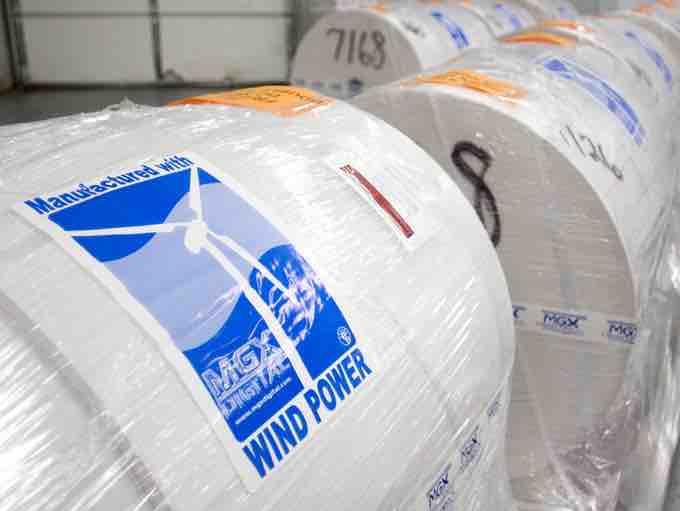Influence on the Entire Supply Chain
Supply chains are crucial functions that allow organizations to translate customer demand into product fulfillment and market delivery. A brand's entire supply chain also includes marketing, which can impact other functions such as sales, manufacturing, and distribution. A primary example are organizations that hire external suppliers to produce marketing materials (print publications, promotional products, and point of sale systems) to market their products and services.

Supply Chain
Marketing flows are often integrated into the larger supply chain of an organization to promote efficiency.
One of the primary responsibilities of marketing is to encourage communication between different parts of an organization to facilitate knowledge sharing. Marketing teams can play an integral role in integrating supply chain business processes, and promoting collaboration between buyers and suppliers, product developers, and common systems. Because operating an integrated supply chain requires a continuous information flow, marketers serve as major internal communication channels between customers, sales, purchasing personnel, and suppliers.
Marketing's Influence on the Supply Chain
On a smaller, but still significant scale are the numerous processes, and internal and external partners companies use to deliver marketing materials to customers and clients. To move a finished product or service to customers, marketing works closely with printers, fulfillment houses, and other vendors to produce communications and execute marketing activities for different target audiences. From product brochures and promotional flyers to point-of-sale systems and store signage, each of these supplies must be acquired, managed, and ultimately distributed to customers, sales teams, branch offices, retail outlets, dealers, distributors, and other key audiences around the world.
In physical distribution, the customer is the final destination of a marketing channel, and the availability of the product or service is a vital part of each channel participant's marketing effort. It is also through the physical distribution process that the time and space of customer service become an integral part of marketing, thus linking the marketing channel with a company's customers (e.g., links manufacturers, wholesalers, retailers).
Marketing flows and processes encourage information sharing throughout the entire supply chain. From customer service representatives providing real-time information on scheduling and product availability, to procurement departments that develop rapid communication systems, such as electronic data interchange and Internet linkage, to convey requirements from product marketing managers more rapidly, organizations must clearly communicate its marketing plan internally to successfully launch products with ever-shorter time schedules. By coordinating with product developers, plant managers (manufacturing), and logistics partners (distribution), companies can use this synergy between its departments to compete effectively in the marketplace and help drive firm revenue.
Subsequently, a brand's entire supply chain generally encompasses:
- Customer relationship management
- Customer service management
- Demand management style
- Order fulfillment
- Manufacturing flow management
- Supplier relationship management
- Product development and commercialization
- Returns management
Sustainability and Social Responsibility in Supply Chains
Sustainability, which uses a triple bottom line incorporating economic, social, and environmental aspects, is another business issue that affects a company's entire supply chain or logistics network. Sustainability represents a company's social, ethical, cultural, and health (SECH) footprint on the surrounding communities where it makes products and conducts business.
Within the last decade, consumers have become more aware of the environmental impact of their purchases and companies' SECH ratings. Often times, marketing and communications professionals are responsible for reporting a company's SECH performance to customers, employees, media, investors, suppliers, and other relevant stakeholders. Greater consumer awareness and involvement around a company's sustainability activities, coupled with the delivery of more transparent marketing communications, arguably places more pressure on other supply chain areas. In response to consumer and market pressures, organizations may enact operational improvements ranging from reducing water use, energy use, and waste, to adopting best practices in governance and employee engagement.
Negative public response over the use of pesticides or the unfair treatment of factory workers have often led to brands selling organically grown foods, adopting anti-sweatshop labor practices, and promoting locally produced goods that support independent and small businesses. For example, in July 2009, Wal-Mart announced its intentions to create a global sustainability index that would rate products according to the environmental and social impacts of their manufacturing and distribution. The index is intended to create environmental accountability in Wal-Mart's supply chain and to provide motivation and infrastructure for other retail companies to do the same.
Supply Chain Challenges
Over time, most supply chains can grow cumbersome as new partners, products, and technologies are introduced to processes. Failing to identify efficiencies and develop best practices can increase costs, reduce service levels, and result in an overall loss of control. Similar growing pains around the adoption and integration of new partners, products, and processes can create inefficiencies in marketing as well, driving up costs and potentially causing delays in other areas of a company's supply chain. For instance, some of the world's largest consulting firms estimate that up to 60% of marketing costs are related to non-product ancillary areas (distribution, people, freight, storage, obsolescence, technology, and inventory management).
It is crucial that brands support marketing functions so they are both managed effectively and integrated seamlessly into the larger supply chain, thereby meeting larger business goals. These range from supporting internal and external collaboration and lead time reduction initiatives, to streamlining feedback from customer and market demand and improving customer-level forecasting.